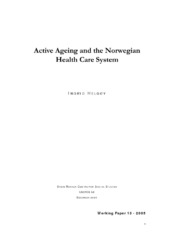| dc.description.abstract | This paper provides results from the fourth work package (WP4) of the Active Ageing project dealing with how the ongoing health policy in Norway has given rise to an Active Ageing agenda. The aim is to identify the institutional, political and socioeconomic barriers and opportunities for implementing active ageing policies in the health care sector in Norway. To which extent have recent health care reforms contributed to national active ageing policy objectives? Active age does not exist as a publicly-expressed aim in the health care policy. Nevertheless, active ageing policies seem implicit in the recent health care reforms. The most important change is the redirection of housing policy for the elderly and the trend toward live at home as long as possible and receiving individually adapted services. However, some challenges still remain. The focus on health care might neglect the social needs of the elderly. Thus, an important precondition for being active is ignored in the policy. Another policy challenge is how the elderly make use of their good health and the possibilities to live an active old age. The trend for the elderly to segregate and live outside the productive sphere is perceived as a problem in the Norwegian policy debate, as politicians want the healthy elderly to make use of their resources in a more ‘productive’ term. Generally, the health care policy has resulted in a good health condition for the population and the preconditions for an active age have never been better. However, due to demographic ageing, authorities are dependent on activity for the healthy elderly to be used in working life in order to lighten the demographic burden. Increased exit from labour market for those aged 60+ gives rise to questions about the health conditions of this group. When it comes to self-reported health, a large percentage of the population live with chronic health problems, somatic pain and psychiatric disorders. This could be part of the explanation for increased exit from the labour market. For retirees within the voluntary scheme, the barriers are not necessarily health conditions nor working place conditions, but economic incentives. Thus, barriers to active ageing in this group seem to be attitudes towards work and leisure, in addition to the overall cultural understanding of old age. Relying on text analysis of academic literature and policy documents, expert interviews and a statistical analysis of quantitative data, this report is structured as follows: First, the health status of the population is outlined followed by health risk statistics. The health care system and policies accommodated toward active aging are then described. How are the challenges met and policies set? In this section, the formal administrative system and policies are presented in addition to the results of interviews with key actors. This presents the actors experiences, knowledge, and apprehensions of the system and policies. Lastly, the findings are reviewed and the policies assessed by analysing the identified barriers and possible opportunities for implementing health policies for active ageing in Norway. | en_US |
| dc.description.abstract | Notatet er utarbeidet innenfor det EU finansierte prosjektet Active Ageing Policy in Europe. Utgangspunktet er de demografiske endringene som innebærer flere passive eldre og færre yrkesaktive i fremtiden. Prosjektet som helhet har som målsetning å identifisere og analysere de institusjonelle, økonomiske og politiske realitetene som møter implementeringen av en aktiv aldringspolitikk i 10 europeiske land. I dette notatet rettes fokuset mot den norske helsepolitikken og hvordan de senere reformer har bidratt til målsetninger om Active Ageing i Norge. Active ageing eksisterer ikke som en uttalt målsetning i norsk helsepolitikk men kan likevel sies å ligge implisitt i de senere reformer i helsesektoren. Et eksempel på det er avinstitusjonaliseringen i den kommunale eldreomsorgen som gjenspeiler trenden til å bo hjemme og motta individuelt tilpasset hjelp. På den annen side er det et hovedfokus på helse i eldreomsorgen noe som kan gå på bekostning av sosiale aktiviteter. En annen utfordring er hvordan eldres bedrede helse kan bidra til mer ”produktiv” aktivitet. I den norske politiske debatten blir det oppfattet som et problem at eldre viser tendenser til segregering på utsiden av den produktive sfæren. Myndighetene peker på at den generelle helsetilstanden er kraftig forbedret og at vi trenger å bruke den fordelen til å lette på den demografiske byrden. På den annen side kan vi stille spørsmål ved helsetilstanden til den økende gruppen av personer på 60 + som slutter i arbeidslivet og blir uføretrygdet. I tillegg oppgir en økende del av befolkningen at de lever med kroniske helseproblemer, fysisk smerte og psykiske problemer, noe som kan være forklaringen til økning i uføretrygden. For personer som går av på grunnlag av AFP virker de økonomiske incentivene sterk i tillegg til innholdet i arbeidsoppgavene. Derfor ligger barrierene mot active ageing for denne gruppen i holdningene til arbeid og fritid i tillegg til vår kulturelle forståelse av alderdom. Notatet baserer seg på tekst analyser av forskningsrapporter og offentlige dokumenter, ekspert intervjuer og statistiske analyser. I første delen presenteres analysen av helsestatus og helserisiko. Så følger en beskrivelse av helse- og omsorgssystemet. I siste delen, basert hovedsakelig på eksperteintervjuene, presenteres de tiltak som kan sies å være rette mot active ageing i Norge, hvilke utfordringer som finnes og hvordan de søkes løst. Notatet slutter av med en identifisering av barrierer og muligheter for å iverksette helsepolitikk rettet mot active ageing. | no |
